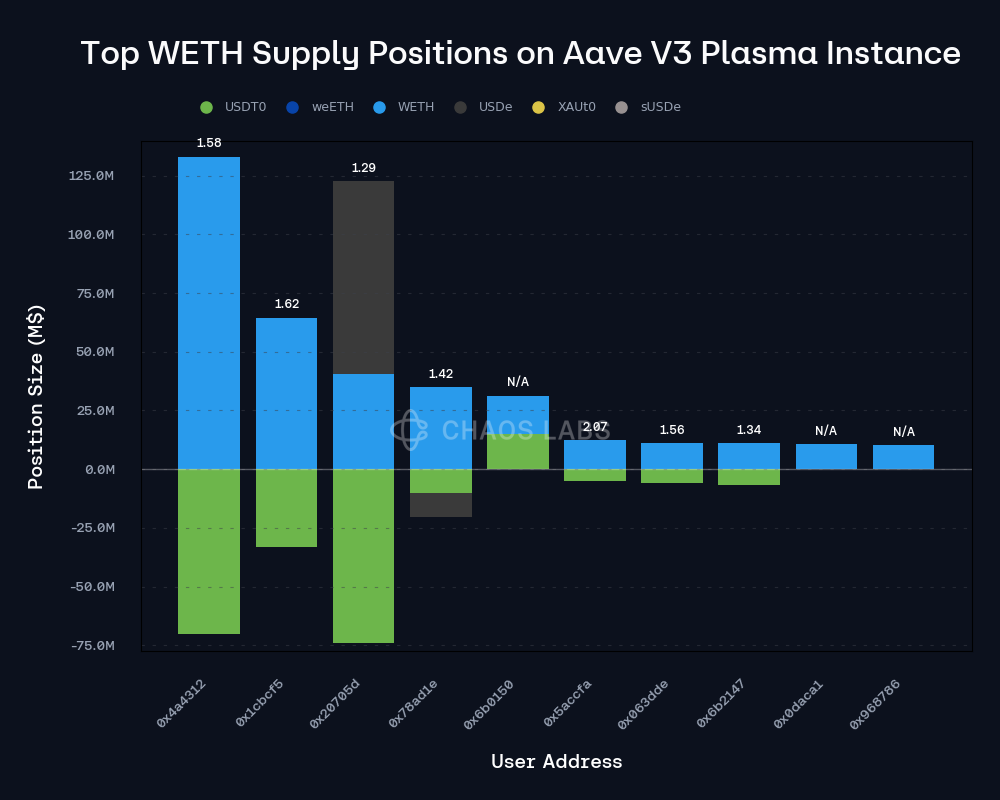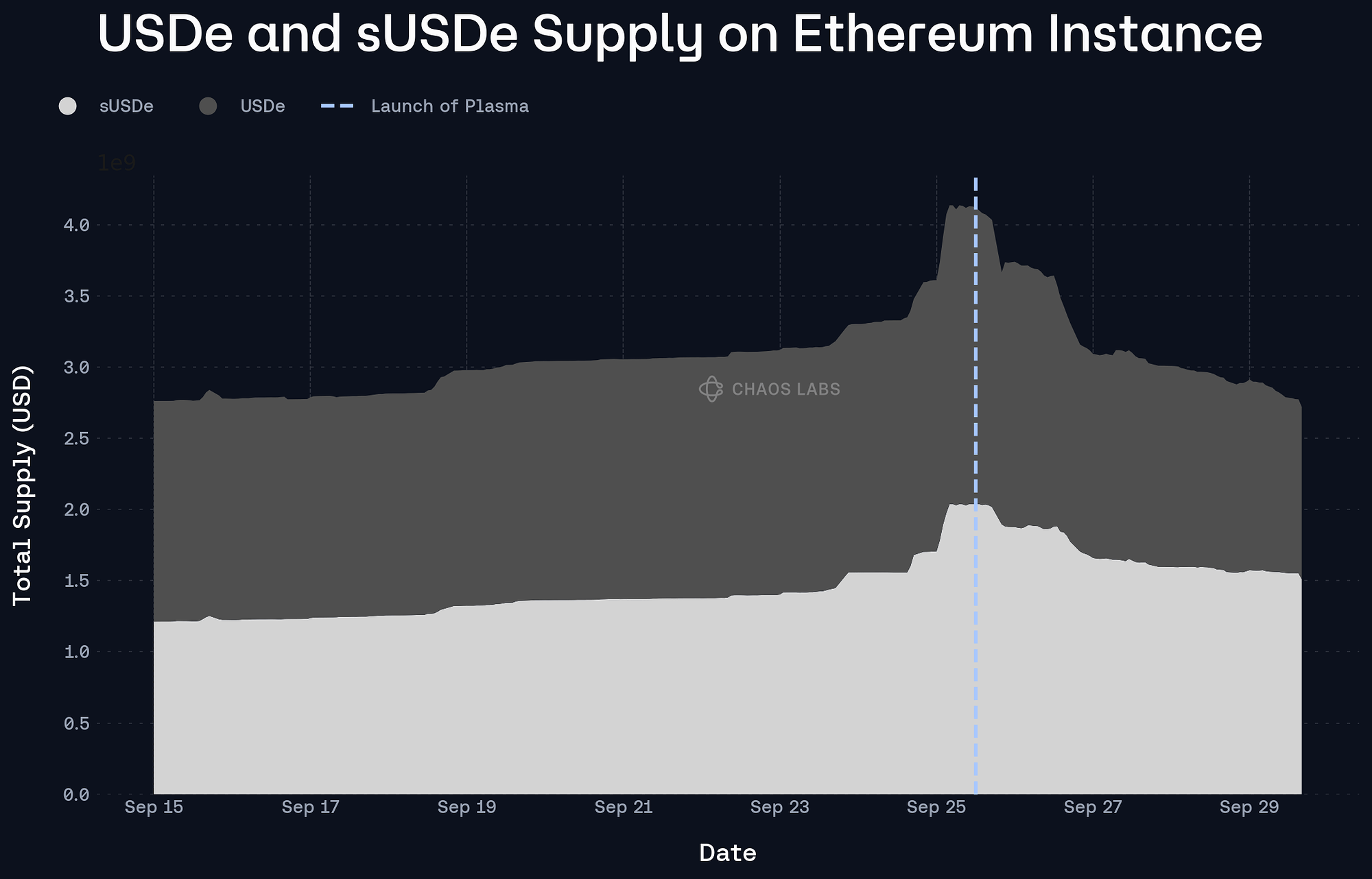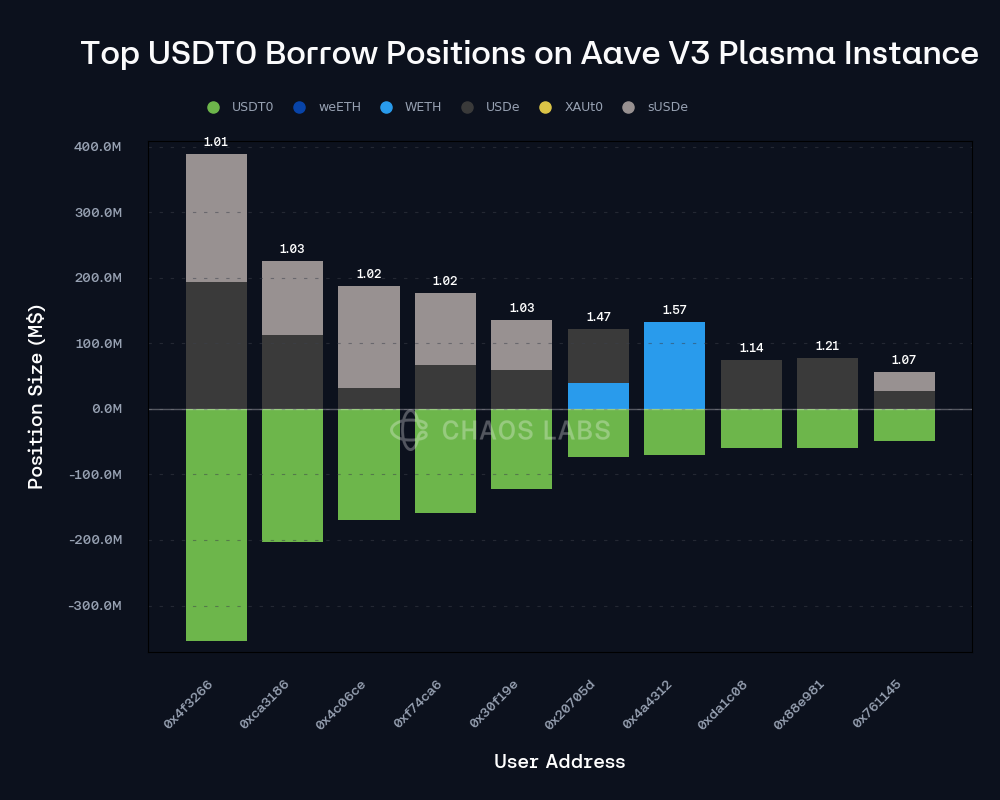Summary
A proposal to:
- Increase the supply and borrow caps of USDT0 on the Plasma instance
- Increase the supply cap of WETH on the Plasma instance
- Increase the supply cap of USDe on the Plasma instance
- Increase the supply cap of sUSDe on the Plasma instance
All cap increases are backed by Chaos Labs’ risk simulations, which consider user behavior, on-chain liquidity, and price impact, ensuring that higher caps do not introduce additional risk to the platform.
WETH (Plasma)
WETH reached its supply caps on the Plasma instance shortly after its last increase through Risk Stewards. At the time of writing, the supply and borrow caps are 120 and 20 thousand tokens, respectively. The recommended parameters were achieved in close collaboration with the Plasma team, aiming to optimize collateral distribution and enhance user retention.
Supply Distribution
The supply of WETH is fairly concentrated, as the top supplier represents over 26% of the total. The majority of suppliers use WETH as collateral to back a substantial amount of USDT0 debt, likely participating in the incentive programs. The distribution of health factors remains safe, ranging from 1.34 to 2.07, limiting the liquidation risk.
Liquidity
At the time of writing, WETH on-chain liquidity on Plasma is mostly allocated in a Uniswap V3 pool, which has over 2,500 WETH and 6 million USDT0.
Additionally, the Plasma protocol team has established a $300M liquidation backstop to ensure efficient execution of liquidations on the Aave Plasma instance during periods of market stress. Chaos Labs will provide additional analysis covering the impact of this liquidation backstop.
Recommendation
Given the persistent demand to leverage WETH on the Plasma instance, safe user behavior, and growing liquidity, we recommend increasing the supply caps of WETH on the instance.
USDe and sUSDe (Plasma)
USDe and sUSDe have both reached their respective supply caps of 1 billion and 900 million shortly after the cap increases. The supply patterns in the assets signal growing and persistent demand.
Supply Distribution
The supply of USDe and sUSDe is fairly distributed, and we observe that the users predominantly use the assets in equal shares to collateralize USDT0 debt position, participating in Ethena’s Liquid Leverage program, which allows for leveraged exposure to Ethena rewards.
Given that the assets are predominantly collateralizing USDT0 debt, the liquidation risk is minimal, as the debt and collateral(s) prices are tightly correlated.
Liquidity
At the time of writing, the majority of sUSDe and USDe liquidity is allocated in the following pools:
- USDT0/USDe Balancer ($32M TVL)
- USDT0/USDe Curve ($15M TVL)
- USDT0/sUSDe Balancer ($27M TVL)
- USDT0/sUSDe Curve ($15M TVL)
The significant liquidity is sufficient to support the growth of the supply caps of the assets.
Impact on Ethereum
The rapid growth of USDe and sUSDe on the Plasma instance, while it has contributed to a significant new inflow, has seen a substantial portion of its deposits migrate from the Ethereum instance.
To prevent the new Plasma market from displacing Aave Ethereum’s deep liquidity, we recommend approaching future supply cap increases of USDe and sUSDe on the Plasma instance conservatively.
Recommendation
Considering the low liquidation risk, safe user behavior, and significant liquidity, we recommend increasing the caps of USDe and sUSDe on Plasma.
USDT0 (Plasma)
USDT0 has reached over 75% of its initial 2.2 billion supply cap in the past hours, indicating elevated demand to supply the asset as the ongoing incentives offer over 20% APY.
Supply Distribution
The supply is highly concentrated, as the top position, at $2.5 billion, represents over 60% of the market; however, this position is held by the Plasma USD Veda vault, which represents the deposits of users who participated in the XPL sale and allows for additional deposits following the chain’s launch. Additionally, none of the top suppliers has outstanding debt, minimizing the risk of forced liquidations.
Borrow Distribution
The borrow demand of USDT is fairly distributed, with the majority of top borrowers using highly correlated collateral such as USDe and sUSDe. The positions that do use volatile collateral, such as WETH and weETH maintain a safe health score of around 1.50. These two elements minimize the liquidation risks in the market.
Recommendation
Given that the overwhelming majority of users are not utilizing USDT as collateral, the risk of large-scale liquidations is minimal. Additionally, the majority of the USDT0 debt remains collateralized by highly correlated assets, reducing liquidation risk. Hence, we recommend increasing the supply cap and borrow caps of USDT0 on Plasma.
Specification
| Market | Asset | Current Supply Cap | Recommended Supply Cap | Current Borrow Cap | Recommended Borrow Cap |
|---|---|---|---|---|---|
| Plasma | WETH | 120,000 | 160,000 | 20,000 | - |
| Plasma | USDe | 1,000,000,000 | 1,750,000,000 | 50,000,000 | - |
| Plasma | sUSDe | 900,000,000 | 1,575,000,000 | - | - |
| Plasma | USDT | 4,000,000,000 | 6,000,000,000 | 3,800,000,000 | 5,000,000,000 |
Next Steps
We will move forward and implement these updates via the Risk Steward process.
Disclosure
Chaos Labs has not been compensated by any third party for publishing this AGRS recommendation.
Copyright
Copyright and related rights waived via CC0.





